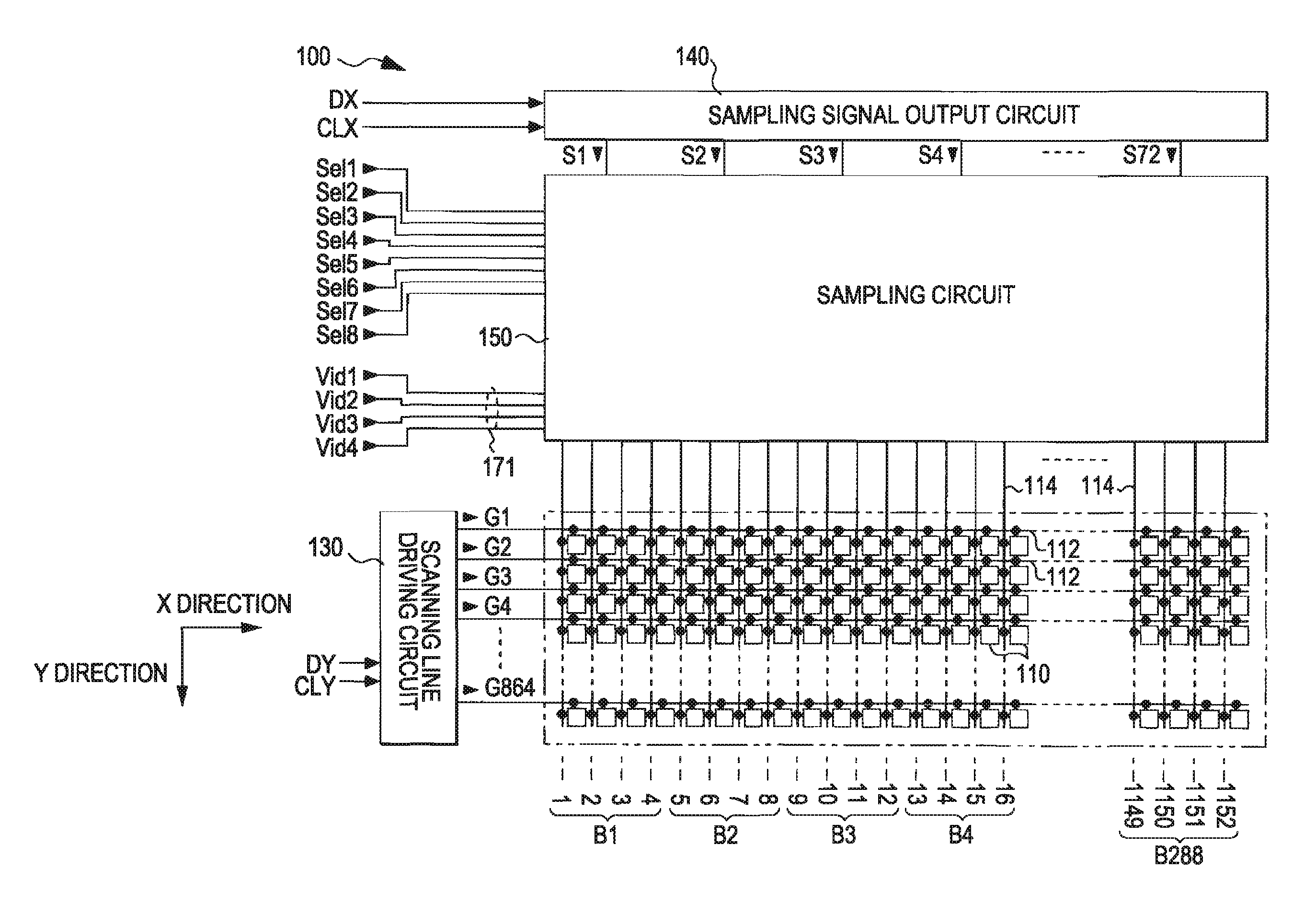Electro-optical device, driving method, and electronic apparatus
- Summary
- Abstract
- Description
- Claims
- Application Information
AI Technical Summary
Benefits of technology
Problems solved by technology
Method used
Image
Examples
first embodiment
Other Example 1 of First Embodiment
[0151] In the first embodiment, the order that the control signals Sel1 to Sel8 are set to an H level, i.e., that is, the order that columns in individual blocks belonging to adjacent groups are selected are selected is as follows:
[0152] in the first frame, 1st time: Sel5→2nd time: Sel2→3rd time: Sel3→4th time: Sel4→5th time: Sel1→6th time: Sel6→7th time: Sel7→8th time: Sel8;
[0153] in the second frame, 1st time: Sel6→2nd time: Sel3→3rd time: Sel→4th time: Sel1→5th time: Sel2→6th time: Sel7→7th time: Sel8→8th time: Sel5;
[0154] in the third frame, 1st time: Sel7→2nd time: Sel4→3rd time: Sel1→4th time: Sel2→5th time: Sel3→6th time: Sel8→7th time: Sel5→8th time: Sel6; and,
[0155] in the fourth frame, 1st time: Sel8→2nd time: Sel1→3rd time: Sel2→4th time: Sel3→5th time: Sel4→6th time: Sel5→7th time: Sel6→8th time: Sel7. However, the above order is not limited thereto but may also be the following order.
[0156] That is, by exchanging the 2nd time and ...
second embodiment
[0167] Next, an electro-optical device (m=3, n=4) according to a second embodiment of the invention will be described.
[0168] In this second embodiment, the control signals Sel1 to Sel6 are adopted in the display panel 100 as shown in FIG. 23, and the sampling circuit 150 is configured as shown in FIG. 24. Moreover, in the second embodiment, the scanning control circuit 52 outputs the control signals Sel1 to Sel6, as shown on the left in parentheses of FIG. 1.
[0169] Now, as shown in FIGS. 23 and 24, the second embodiment differs in blocks and groups from the first embodiment. In addition, in the second embodiment, the data lines 114 of 1152 columns are blocked every three columns. Therefore, 1st, 2nd, 3rd, . . . , and 384th blocks when being numbered from the left are denoted by B1, B2, B3, . . . , and B384, respectively.
[0170] In addition, as shown in FIG. 24, grouping is the same as that of the first embodiment in that the grouping is performed every four blocks. In addition, in...
third embodiment
[0186] Subsequently, an electro-optical device (m=2, n=4) according to a third embodiment of the invention will be described.
[0187] In this third embodiment, the control signals Sel1 to Sel4 are adopted in the display panel 100 as shown in FIG. 31, and the sampling circuit 150 is configured as shown in FIG. 32. Moreover, in the third embodiment, the scanning control circuit 52 outputs the control signals Sel1 to Sel6, as shown on the right in parentheses of FIG. 1.
[0188] Now, as shown in FIGS. 31 and 32, the third embodiment differs in blocks and groups from the first and second embodiments. In addition, in this embodiment, the data lines 114 of 1152 columns are blocked every two columns. Therefore, 1st, 2nd, 3rd, . . . , and 576th blocks when being numbered from the left are denoted by B1, B2, B3, . . . , and B576, respectively.
[0189] In addition, as shotgun in FIG. 32, grouping is the same as those of the first and second embodiments in that the grouping is performed every four...
PUM
 Login to View More
Login to View More Abstract
Description
Claims
Application Information
 Login to View More
Login to View More - R&D
- Intellectual Property
- Life Sciences
- Materials
- Tech Scout
- Unparalleled Data Quality
- Higher Quality Content
- 60% Fewer Hallucinations
Browse by: Latest US Patents, China's latest patents, Technical Efficacy Thesaurus, Application Domain, Technology Topic, Popular Technical Reports.
© 2025 PatSnap. All rights reserved.Legal|Privacy policy|Modern Slavery Act Transparency Statement|Sitemap|About US| Contact US: help@patsnap.com



